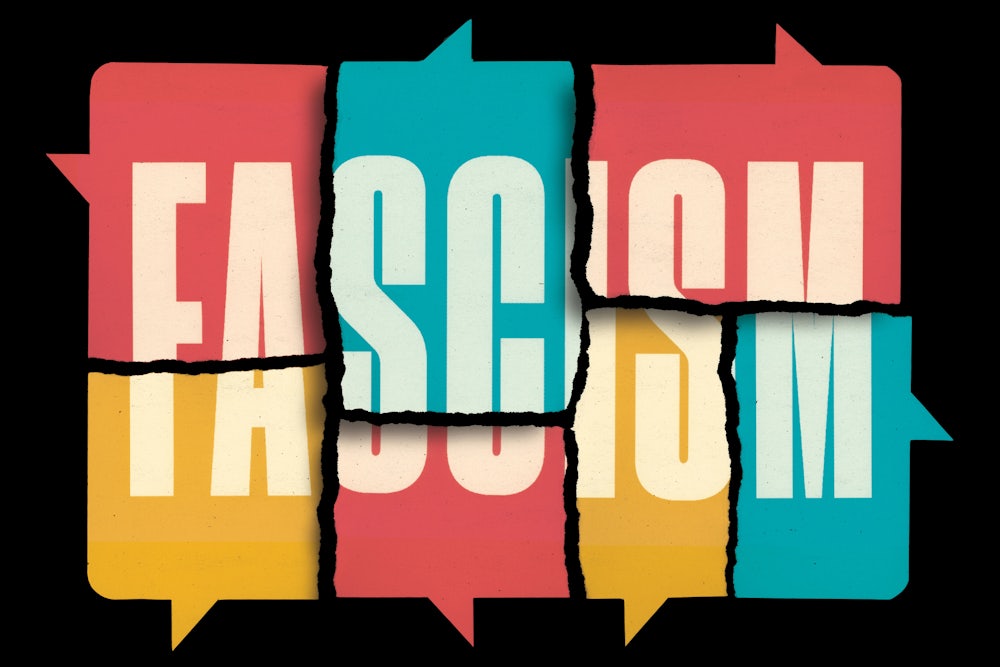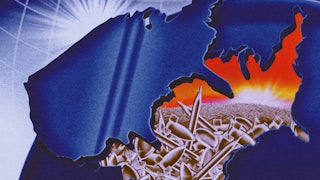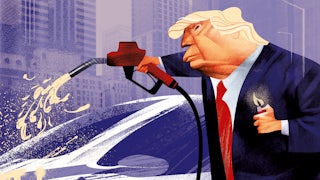Since the election of Donald Trump, a specter has haunted the United States—the specter of fascism. From The New York Times to The Atlantic, from CNN to The New York Review of Books, liberals and socialists alike have asked the same question: Is it happening here?
Answers have run the gamut. Some insist that the similarities between contemporary American populism and fascism—their shared racism, reliance on the petit bourgeois, hypernationalism, and xenophobia—indicate that fascism, finally, has come to America. Others disagree, maintaining that the enabling structural conditions of classical European fascism—firsthand experience of total war, a powerful left, and a relatively weak state capable of being taken over—no longer exist, and that, whatever right-wing populism is, describing it as “fascist” occludes more than it illuminates.
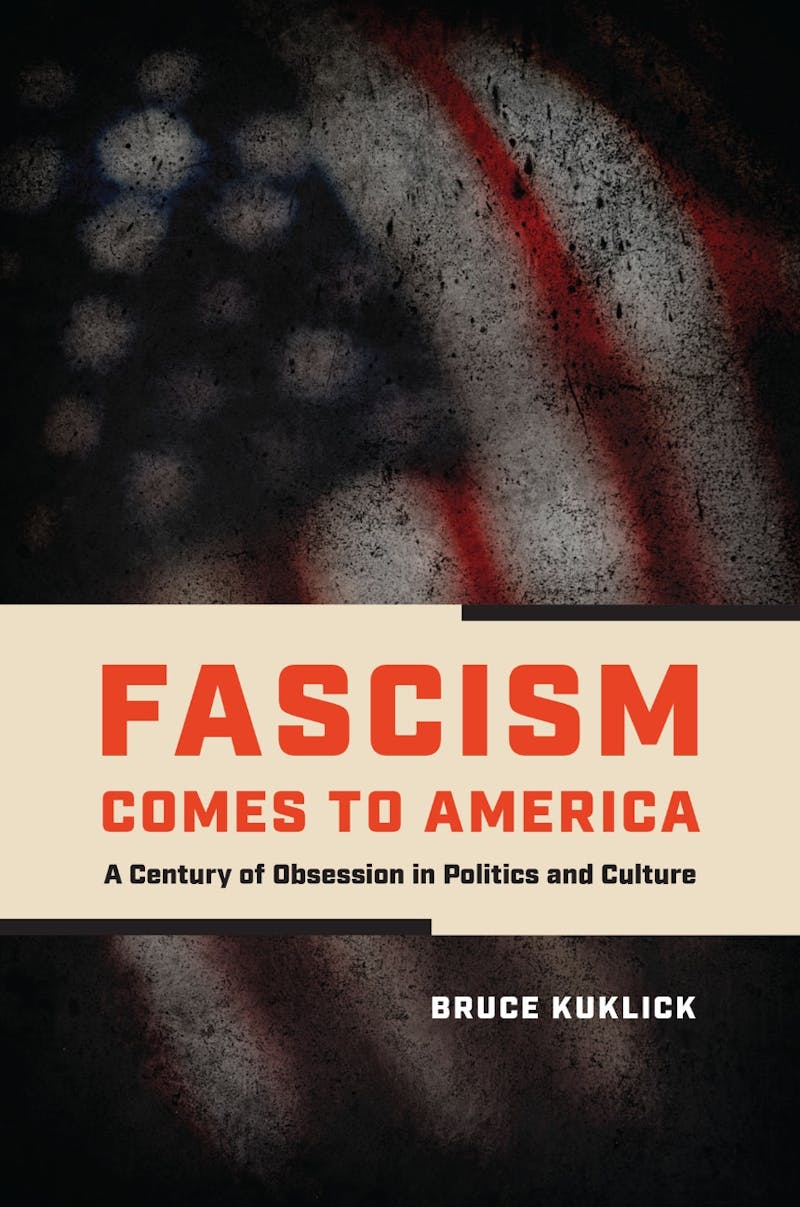
Into this fray enters the intellectual historian Bruce Kuklick, whose Fascism Comes to America provides an entirely new perspective on a debate that’s become a bit exhausting. Unlike other pundits and thinkers, Kuklick is not interested in whether “fascism” as such has arrived in the United States. Rather, he’s concerned with how the term itself has been used in the last century of American discourse.
“Fascism,” Kuklick’s exhaustive survey of U.S. politics and culture shows, has generally functioned as a so-called floating signifier. In the words of the anthropologist Claude Lévi-Strauss, who originated the phrase, a floating signifier is a term “void of meaning and thus apt to receive any meaning.” At one point or another, every political perspective in the United States has been identified as fascist. In the last two decades alone, Jonah Goldberg railed against “liberal fascism” as Chris Hedges dubbed the “Christian Right” “American fascists.” Dinesh D’Souza claimed that Hillary Clinton was fascist; Paul Krugman said the same about Trump. And even fringe ideologies weren’t safe: Sebastian Gorka linked socialism with fascism, while Nouriel Roubini made similar claims about libertarianism.
The one consistent quality the term “fascism” has retained since the 1930s is its negative valence. Almost no one uses it positively; instead, to borrow Kuklick’s acid description, the term is the verbal equivalent of “throwing a tomato at a speaker at a public event.” “Fascism,” Kuklick shows, “does not so much isolate a thing as it does some stigmatizing.” Indeed, fascism’s power in American discourse comes from the fact that it has no stable meaning—it’s mostly an all-purpose curse word, a highfalutin “fuck this”—which means that the fascism debate, as currently constructed, can never end.
The term “fascism” first entered popular discourse in 1921, when Italian dictator Benito Mussolini christened his political party the National Fascist Party. Mussolini employed the word, which derives from the Italian fascio, meaning “bundle,” for two reasons. First, it signified his conviction that the Italian people were stronger when individuals acted as a coherent unit. Second, it referenced the Roman “fasces,” a bundle of rods ancient magistrates used to symbolize their strength and, if necessary, to flog wrongdoers. With this one word, Mussolini displayed both the promise and threat of his movement.
Initially, some American intellectuals were intrigued by the romance of Italian fascism. One prominent example was Herbert Croly—a founder of The New Republic—who saw in fascism a potential means to rescue a Progressivism that by the 1920s was in steep decline. Croly insisted that Mussolini’s vibrant movement rhymed with American-style Progressivism: Both fascism and Progressivism emphasized “supraindividual obligations” to people and nation over parochial individualistic ones and fetishized pragmatic politics. Mussolini, in fact, even listed the pragmatist philosopher William James, a lodestone for Progressives, as a primary influence. To thinkers like Croly, these similarities suggested that fascists might have something to teach Americans.
“Fascism” only became a dirty word in American discourse in the 1930s, as Mussolini’s Italy became increasingly associated with Adolf Hitler’s Germany. As they had admired Mussolini, some Americans initially admired Hitler for his seeming ability to reinvigorate German society through the establishment of programs like “Strength Through Joy,” which encouraged internal tourism. But by the mid-1930s the luster began to come off both Nazism and Italian fascism. In 1934, Hitler violently purged his own ranks in the infamous Night of the Long Knives. A year later, the German dictator passed the Nuremberg Laws while the Italian one invaded Ethiopia; a year after that, Germany seized the Rhineland, and Hitler and Mussolini united to form the Rome-Berlin Axis.
These events led Americans to identify Mussolini with Hitler—and fascism with Nazism. Because Americans concluded that Mussolini was “in the thrall of Hitler,” by the end of the 1930s “the negative connotation of fascism had become irrevocably blurred: while the Italians hardly counted, Hitler was routinely and haphazardly identified as fascist.” Il Duce was left in der Führer’s dust.
But even at this early stage in its history, fascism functioned as more than a neutral descriptor; it instead acted as a “foul noun of preference” that Americans “deployed … against anyone with whom they disagreed politically.” The most popular targets of opprobrium were President Franklin Delano Roosevelt and his New Deal. At various points in the 1930s, a number of notable figures derided FDR or the New Deal as “fascist,” including liberal philosopher John Dewey (who worried FDR was creating a “police state”), socialist politician Norman Thomas (who worried FDR was beginning to resemble Mussolini), former Republican President Herbert Hoover (who likewise worried FDR was too similar to European dictators), and populist Senator Huey Long (who worried FDR was too close to the business class). But the president was hardly the only one ridiculed in this fashion. As Kuklick highlights, until the U.S. entry into World War II, “everyone called anyone a fascist.”
No incident displays the term’s malleability more than an informal 1937 survey undertaken by the social theorist Stuart Chase, who asked almost 100 people “what ‘fascism’ meant to them.” The respondents offered a range of diverse, even antithetical, definitions: A lawyer said “fascism” was “a coercive capitalistic state,” while a housewife identified it as the “same thing as communism”; an author answered that it was “an all-powerful police force,” while a farmer characterized it as “lawlessness”; a social worker described it as “government in the interest of the majority,” while a journalist insisted it was “undesired government of [the] masses by a self-seeking, fanatical minority.” Still, while the respondents provided diverse interpretations of fascism, most agreed that, whatever fascism was, they didn’t like it. Or as a schoolboy put it with youthful bravado, fascism was “something that’s got to be licked.”
It took the U.S. entry into World War II to solidify how “fascism” was used. Once the United States joined the Allied effort after the 1941 Japanese attacks on Pearl Harbor and other U.S. possessions, political categories crystallized. Now, “America battled Germany, Italy, and Japan—countries all specified as fascist.” Though FDR still had his critics, they were less likely to designate the president a fascist. In short, the identification of the Axis as fascist and the wartime desire for unity combined to make haphazard allegations of fascism a thing of the past—at least for a time.
One might have expected “fascism” to perish in 1945 along with the Nazi regime with which it was associated. But, while the term was used far less after the war than it was during it, it nonetheless became a permanent part of the American lexicon. Why didn’t fascism die an ignoble death like once-popular but eventually discarded political identifications like Whig, Know-Nothing, and Dixiecrat?
The reason, Kuklick argues, is that by the time the United States entered the war, American governance had begun to be defined by a novel approach to politics dubbed “welfare liberalism,” whose proponents positioned themselves against “fascism on the right and communism on the left.”
Strange as it seems to us today, before the 1940s Americans rarely employed the European political spectrum, which pitted a reactionary “right” against a socialist “left,” to understand their own politics. Instead, most literate Americans believed that their country enjoyed “its own political divisions that sat apart from those of Europe.” Whenever Americans did make use of the European spectrum, it was usually to point to a radical “left” of which they wanted little part. In a sense, before the 1940s, the United States had an immoderate left but no “immoderate right.” Abhorrent tendencies in U.S. politics presently identified as on the far right, such as avowed white supremacy, resided comfortably in the mainstream, especially since the Democratic Party relied on its segregationist wing to pass and promote the New Deal.
The welfare liberals changed this by strategically utilizing the European political spectrum to define themselves as the moderate center. To do so, they needed an extreme right wing, and they found one in fascism. By developing and promoting an American political spectrum that placed fascism on the extreme right and communism on the extreme left, liberals were able to present themselves and their platform—limited government intervention at home, support for “democracy” abroad—as the embodiment of a rational, “vital center.” Put another way, during and after World War II, fascism became a useful foil against which centrist liberals defined themselves and justified the creation of an expanded welfare state and U.S. empire that, for the first time in history, spanned much of the globe.
From the late 1940s to the late 1960s, “fascism”—which surpassed Nazism and National Socialism in common usage—had a relatively stable meaning: It referred to the extreme right-wing of the recently adopted political spectrum. Nevertheless, one must be careful not to overstate the term’s import; for most of this period, it was communism, not fascism, that preoccupied the American mind. In fact, it was primarily German exiles like Albert Einstein, Theodor Adorno, and Herbert Marcuse who kept the term in circulation.
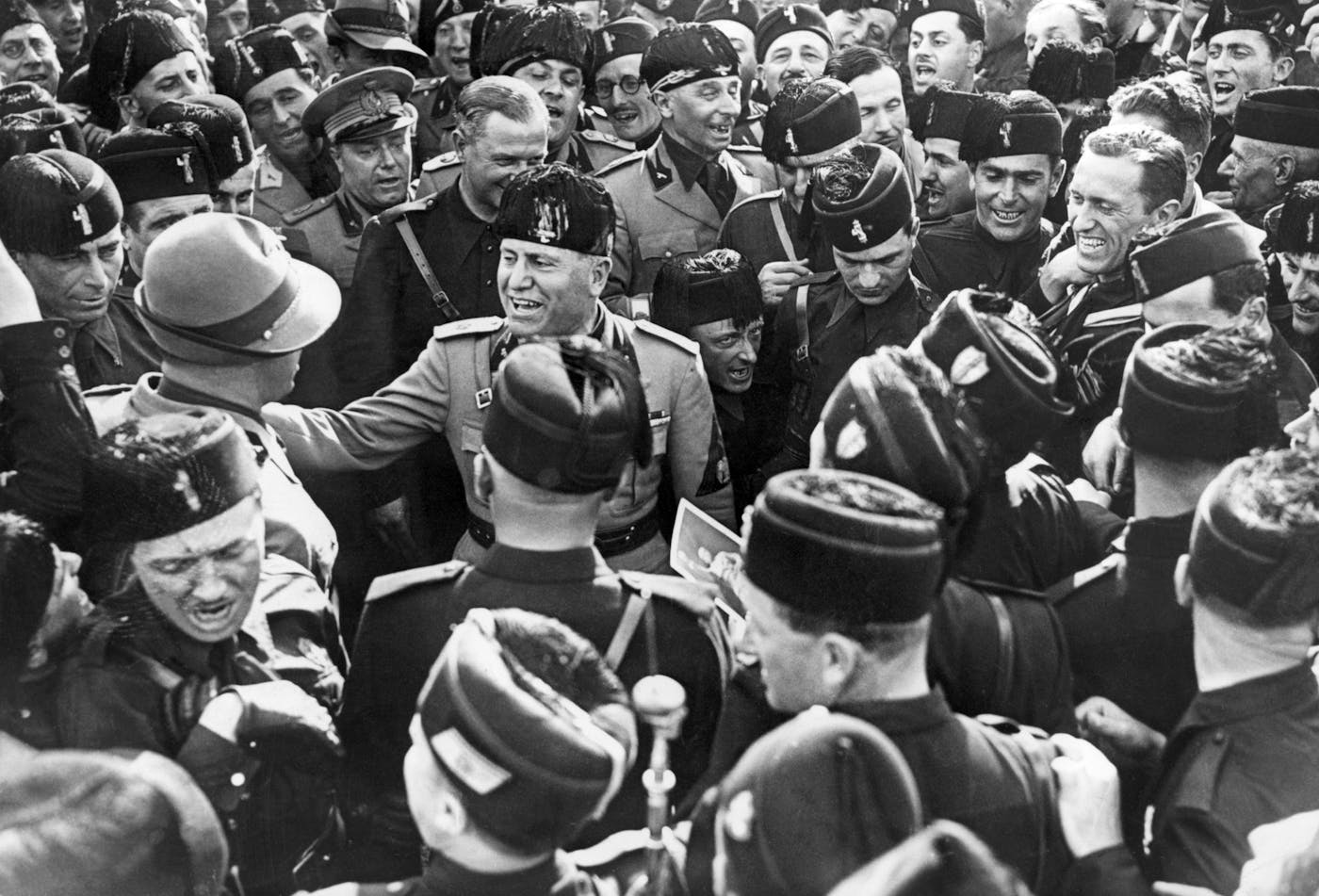
Things changed—or rather returned to their pre–World War II state—during the Vietnam War. Anti-war baby boomers, who had not fought fascism firsthand, but who had grown up in its dark shadow, once again started to apply the term to politicians across the political spectrum, from Lyndon Baines Johnson to Richard Nixon. Fascism thus retained its exceedingly negative valence, but was, Kuklick shows, “untethered … from the right” and even “uncoupled from any perceptive characteristics.” If you really didn’t like someone or something, you called them fascist.
This is not to say that those who used the term never had noble intentions, especially from the perspective of the left. In several instances, left-wing thinkers concluded that they needed to employ “fascism” to help Americans appreciate that sometimes the policies of their liberal capitalist society uncomfortably mirrored those of Nazi Germany. In particular, when Angela Davis used the term in her 1971 essay “Political Prisoners, Prisons, and Black Liberation” to inveigh against “the fascist content of the ruthless aggression in Indo-China” and “the fascist stronghold in the prisons,” she was trying to force people to confront painful and profound instances of violence, oppression, and injustice.
But Davis’s form of use never predominated, and in general, for much of the 1960s onward, innumerable people deployed the term in innumerable ways. Everyone, from Ronald Reagan to Bill Clinton, from Barack Obama to George W. Bush, has at one point or another been deemed a “fascist.”
Fascism, in other words, has not generally functioned as a term of analysis—as Kuklick demonstrates, it doesn’t have “much empirical content.” It is instead “a part of language that is more evaluative than factual.” For most of its American history, fascism has been an insult, a performative reflection of the user’s desire to make the object of their derision disreputable.
Kuklick is therefore “skeptical” of the mounds of scholarly research that have utilized “fascist” to describe governments, movements, and people not linked to Mussolini’s Italy or Hitler’s Germany. Like much research into political topics, this work, he claims, “continues politics by other methods” and “displays standard sentiments as much as … disinterested information.”
Kuklick is especially critical of attempts to read fascism into the American past, which many scholars have done since the late 1960s. Finding fascism in U.S. history, he warns, “distances U.S. citizens from their own past” by insisting that “dangerous challenges … must have migrated from overseas.” There are manifold homegrown American phenomena that shaped the past for the worse—genocidal racism, rapacious militarism, and a violent obsession with incarcerating minorities were not fascist inventions—and we hardly need to import a term with a foreign valence to explain (and thus implicitly detach ourselves from) that history.
Why has “fascism” been able to serve such a protean function? According to Kuklick, it’s because fascism hasn’t been, and never was, a real threat in the United States. As he usefully reminds us, “living, breathing Nazis—the German-American Bundists and William Dudley Pelley’s Silver Legion of the 1930s; George Lincoln Rockwell’s American Nazi Party of the 1960s; or the neo-Nazis of the 21st century”—were all minuscule groups that never came close to wielding political power. The conditions that enabled fascism’s rise—a broad experience of total war and a powerful left on the verge of seizing power—were just never present here. It was precisely this lack of threat that allowed fascism to become a generalized term of vilification. If there were actual fascists running around, you wouldn’t go around calling everyone fascist.
Another reason “fascism” has been so protean is that, unlike liberalism and conservatism, it’s not a living ideology—and never really was in the United States. No self-identified fascist is taken seriously in American society. There are no genuinely fascist op-ed columnists, no fascist TV commentators, no fascist celebrities, no fascist elected officials. You’re unlikely to find people reading actual fascists outside of European history courses. When a right-wing provocateur like Matt Walsh refers to himself as a “theocratic fascist,” he does so with a wink and nod, knowing that he’s using a term sure to rile up liberals and leftists. Fascism is a dead ideology, which ironically has allowed it to rise from the grave in easily manipulable zombified form.
Beyond its versatility, there are several additional reasons why fascism has become such a powerful term in American discourse. First, as Angela Davis’s use of the word suggests, sometimes left-wing thinkers have determined that to impel Americans to confront difficult truths, only the word “fascist” will do. Using the term further enables individuals to indicate that they’re “one of the good guys.” When anti-war activists identified George W. Bush with Hitler in the 2000s, they were not so much making a careful historical analogy as signaling their hatred of Republican warmongers and, in most cases, their allegiance to the Democratic Party.
Moreover, in eras like our own, in which rampant polarization co-exists with a political structure in which most citizens have no influence, it’s only natural for people to construct struggles that give their lives political meaning. Identifying “fascists” allows Americans living today to imagine themselves as part of a consequential world-historical fight between good and evil. It’s an ahistorical framing that gives meaning through romantic nostalgia and provides psychic succor to all of us who have no influence in the corridors of power.
The contemporary fascism debate is thus about much more than fascism—it’s about people’s sense of self in a moment of anti-popular politics. And it is for this reason that the debate, which on its surface is as academic as a discussion could possibly be, has engendered so much rancor: When you attack someone’s identification of fascism, you’re attacking more than a political diagnosis; you’re attacking their very identity.
Nonetheless, something did change with the rise of Donald Trump, whose success reopened the floodgates of fascism talk. Not since the 1930s and 1940s have the literati obsessed so much over fascism, and not since the 1950s and 1960s has the term been so associated with the political right.
At first glance, it’s not obvious why so many more critics identified Trump as fascist instead of, say, George W. Bush. Bush, after all, established government bodies like Immigration and Customs Enforcement, the most Gestapo-like organization in the country, and the Department of Homeland Security, whose name uncomfortably echoes the German Heimatschutz, a term associated with the far right. Moreover, Bush’s policies—undermining FEMA, invading Afghanistan and Iraq—inarguably resulted in the death and displacement of far more people than Trump’s.
Some might say that the actions taken by Republicans in the years since 2016 are more dangerous than those they took in the 2000s, that the Trump GOP’s claims of voter fraud and its attempts to limit voter participation threaten democracy in a way Bush’s GOP never did. I find this hard to credit, given that Bush’s many accomplishments—stealing an election, starting pointless wars, violating sundry civil liberties—are objectively more damaging (and more Nazi-like) than anything that Trump and his GOP tried to implement.
Others might argue that the rise of far-right groups like the Proud Boys and Oath Keepers, and especially their participation in the “insurrection” of January 6, 2021, suggest that there’s an unprecedented threat to U.S. democracy that only the word “fascism” can describe. But organizations like these have existed for decades and undertaken numerous spectacular acts—the Oklahoma City bombing of 1995 comes immediately to mind, as do the murders of doctors providing abortions—and the term “fascist” was not usually applied to them.
A similar argument is sometimes made about the rise of far-right governments around the world in places like Hungary, Poland, Russia, and Turkey. But, again, these types of autocratic governments have long been a feature of international politics and were not generally identified as “fascist.”
It therefore seems that one must look elsewhere to explain the explosion of fascism talk since 2016.
To my mind, the major reason fascism talk has lately reached a crescendo is that, for the first time in almost a century, liberalism finds itself in crisis. The utopian promises made in the 1990s and 2000s, when liberals averred that we were at “the end of history,” have not come true. The economy has collapsed multiple times. Inequality has increased. U.S. attempts to promote “democracy” abroad have failed as Eastern Europe, once the site of liberalism’s greatest triumph, has lurched to the right. Bernie Sanders has reinvigorated Americans’ interest in social democracy. And the loutish Trump’s victory indicated that many Americans are tired of adhering to liberal norms of engagement and exchange. Liberalism is weaker than it has been since the Great Depression.
For most of the twentieth century’s second half, liberalism was kept vigorous and popular because it was able to define itself against a communist enemy, which, liberals affirmed, was the primary obstacle standing in the way of a better world. But communism has been defeated, and 30 years later everything looks and feels pretty much the same, only worse. Liberals therefore need a credible enemy whose viciousness might attract Americans to the centrist cause and, in the process, help them overlook liberals’ manifold and manifest failures. Simply put, fighting fascism provides liberals with an opportunity to reinvigorate their project in a moment of crisis. This is why fascism talk exploded under Trump and not under Bush; under the latter, liberal dreams had not yet curdled.
But this still doesn’t answer the normative question: Should we on the left use the term “fascism”?
To many, it might not matter that “fascism” has no coherent analytical meaning—what matters is that it’s a politically useful way, first, to force people to appreciate that U.S.-style liberal democratic capitalism doesn’t prevent oppression of the kind that occurred in Nazi Germany, and, second, to mobilize people against right-wing extremism.
I’m not persuaded by the first argument. I have yet to see compelling evidence that indicates invoking fascism leads Americans to confront racialized state violence. Leftists have been using fascism as a term of abuse for decades, and it doesn’t appear to have had much effect on how the population understands society.
I am also skeptical of the claim that using the term “fascism” is an important means to mobilize people against the far right. It seems to me that there are likely more meaningful ways to rally one’s side against reaction that are centered less on abstract concepts and more on promising, and giving, people money and benefits, as the recent success of John Fetterman’s populist campaign suggests. Unfortunately, there’s no extant data that can definitively settle the question: According to polls conducted by the firm Citizen Data, in the 2022 midterm elections voters who split their ticket “in five battleground states … were strongly motivated to respond to threats to democracy.” Was the fascism framework an important part of the effort to make voters anxious about democracy’s survival? We just don’t know, though the message “we need to defend democracy” by no means depends on identifying fascism, and we could discard the latter without losing much.
As we move further into the twenty-first century, it’s worth asking whether using a twentieth-century term that inevitably invokes images of brown-shirted thugs beating down doors and black-shirted psychopaths running death camps will help us solve the problems we face. Neither climate change, nor inequality, nor structural racism, nor the general hopelessness that has permeated American society will be defeated in ways that resemble the Allies’ defeat of fascism.
It may therefore be time to retire the term. Not only is its political utility doubtful, but Kuklick has demonstrated that there is no fascist object “out there” to discover. There is thus no way to end the fascist debate. Agreement or consensus is unlikely to be reached. It’s time to let go.
